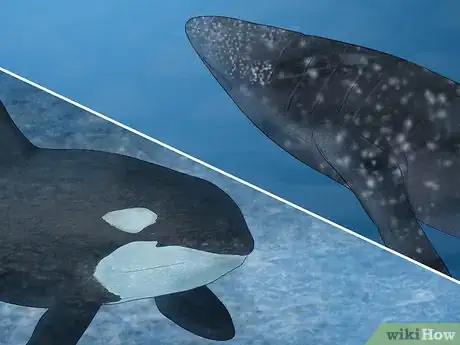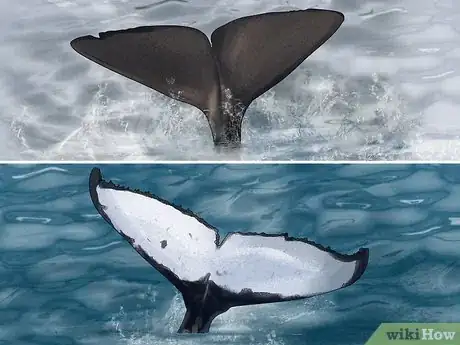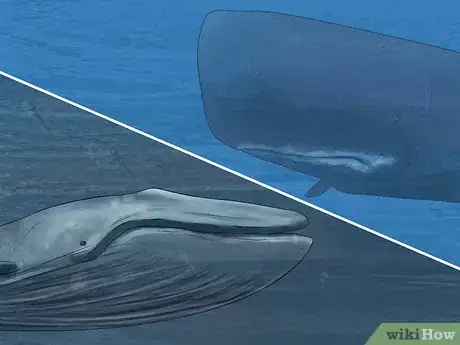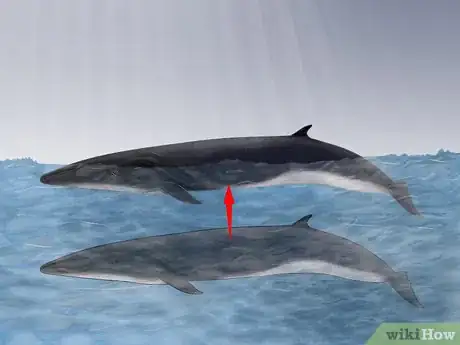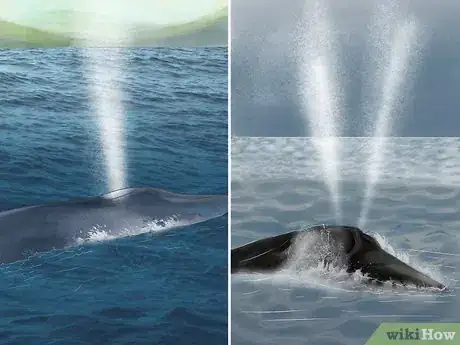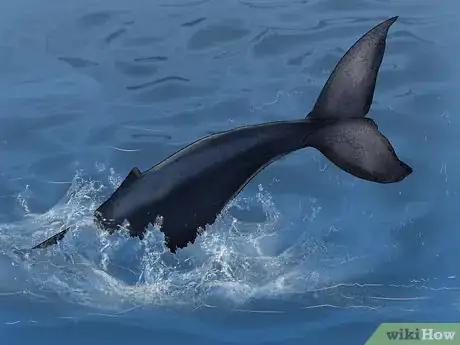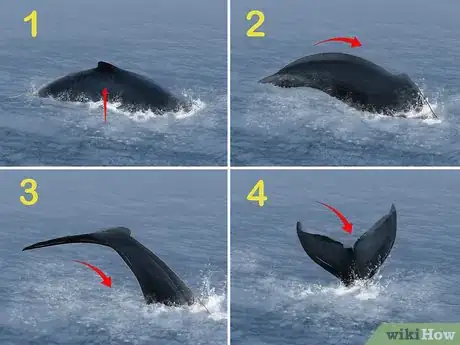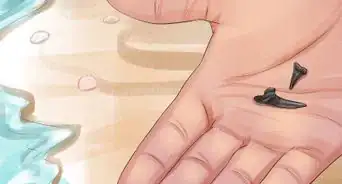This article was co-authored by wikiHow Staff. Our trained team of editors and researchers validate articles for accuracy and comprehensiveness. wikiHow's Content Management Team carefully monitors the work from our editorial staff to ensure that each article is backed by trusted research and meets our high quality standards.
There are 7 references cited in this article, which can be found at the bottom of the page.
This article has been viewed 19,884 times.
Learn more...
Many people enjoy traveling out on the oceans to spot whales, but they do not know how to distinguish them from other species. By paying attention to characteristics and behaviors, you can recognize these majestic creatures. It can be difficult to get a good glimpse of a whale, so even small details like size and coloring can help. Patiently watch for the whale to surface so you can identify it.
Steps
Distinguishing Whales by Appearance
-
1Estimate the whale’s size. You may only see part of the animal, so figuring out its length can be difficult. Try to compare it to the length of a nearby object, such as a boat. Estimate the whale’s general size range, such as 10 to 20 ft (3.0 to 6.1 m).[1]
- For example, animals under 10 ft (3.0 m) are probably dolphins or porpoises.
- Animals over 60 ft (18 m) are likely the biggest whale varieties, such as blue or fin whales.
-
2Check for a dorsal fin on the whale’s back. The dorsal fin is the lone fin on the whale’s backside. Be careful not to confuse it with the whale’s flippers. First, see where the fin is positioned on the whale’s body. Note the fin’s size and shape.[2]
- For instance, many whales have small fins positioned near their tails.
- Dolphins and porpoises have longer, pointed fins in the middle of their bodies. Dolphins often have curved fins.
- A sperm whale, for example, has a small hump instead of a fin.
Advertisement -
3Look for colors and patterns on the whale’s body. Sometimes, you can catch a glimpse of a unique coloring or pattern that allows you to identify the whale right away. You may not get a good enough view to identify the whale through color alone. If this happens, combine the information on the whale’s coloring, size, and fin shape to help identify it.
- For instance, killer whales are recognizable by their black and white coloring.
- Gray whales have a mottled gray, patchy coloring, whereas fin whales have white underbellies.
-
4Check the size and color of the whale’s tail. The tail, or fluke, is typically much larger in whales than dolphins and porpoises. Whale flukes branch off into 2 sail-shaped fins at the end. The whales use these to propel themselves through water. The size, shape, and coloring varies between species.[3]
- The best time to see the fluke is when the whale surfaces. Some species raise their flukes to dive again.
- Humpback whale flukes, for instance, have white spots or undersides and ridges on the ends.
- The fluke is smooth and black on southern right and sperm whales.
-
5Look at the colors and features of the whale’s flippers. The flippers will be on the whale’s sides. Each species has slightly different flippers. Note the size and shape of the flippers. Flippers are often the same color as the whale’s body, but some may have recognizable patterns.
- Whale flippers are often small, triangular, and slope backwards towards the whale’s tail. Dolphin flippers by contrast are long and sickle-shaped.
- Minke whales have white patches on top of their flippers. Humpback whales have flippers with white undersides.
-
6View the whale’s head structure. Sometimes whales stick their heads above the surface. If you are lucky enough to get a glimpse of the head, you may find identifying the whale easier. Large whales often have sloping, almost pointed heads. Smaller whales, dolphins, and porpoises have rounded heads.
- The sperm whale is easily identified by it’s large, square-shaped head.
- Beaked whales, which often stay in deep water, have rounded heads.
-
7See if the whale has a beak nose. Large whales do not have snouts protruding from their heads. These “beaks” are often seen in dolphins as well as smaller whales that don’t come near the shore. If you sail out into deep waters and catch a glimpse of a beak nose, you may be able to identify a beaked whale.
- Beaked whales are relatively small, have jutting snouts, travel in packs, and rarely come to the water’s surface.
Watching Whales Dive
-
1Watch how often the whales surface. Whales have to come up for air every so often. The amount of time a whale can spend underwater depends on the species. In general, larger whales can stay underwater longer.[4]
- Smaller animals, such as dolphins, stay underwater 10 to 20 minutes at a time.
- A sperm whale, for example, can stay underwater for up to 90 minutes.
-
2Notice the size and shape of the water blow. The blow or spout happens when the whale reaches the surface. Each whale expels water in a unique pattern, almost like a fingerprint. If you notice a water spout, watch the general area for the whale to return to the surface again.[5]
- Gray whales and right whales have 2 blowholes, so they produce a heart-shaped spout.
- Sperm whales spray water diagonally forward, unlike other species.
-
3Watch how often whales breach and slap their tails. Breaching is when the whale rises above the water's surface. Some species jump out of the water, while others may only raise their heads above the water. Other whales slap their tails against the water to communicate or begin diving.[6]
- Humpback whales, for instance, are more agile than other whales and often jump out of the water.
- A few other species, like fin and minke whales, sometimes bring their heads up above the water.
-
4Identify the whale’s dive sequence. After the whale comes to the surface, it will eventually dive again. Some species have unique ways of doing this. Keep an eye on the whale’s tail and note how far the animal extends above the water before diving.[7]
- For example, humpback and sperm whales raise their large tails out of the water.
- Porpoises come to the water surface before diving. Dolphins often leap out of the water.
Determining Travel Patterns
-
1Find out which species are common in your location. Generally, a limited number of whales, porpoises, and dolphins live in each part of the ocean. If you know which species are common in your area, you will have a better chance of identifying the whales.[8]
- Try looking up a whale-spotting guide online for your area. Whale-spotting groups and some governments publish these guides.
-
2Learn when whales travel through your area. Whales move to different parts of the ocean throughout the year. They often travel in search of warmer waters. Different species migrate during different parts of the year, so whale sightings might be more common depending on the month.
- In California, for example, gray whales appear in the winter. Humpbacks and blue whales show up in summer.
- Some whales may be seen year-round. The fin whale can always be spotted near California, but it is most frequent there in summer and winter.
-
3Note how many whales are traveling together. Most larger whales travel alone or in very small groups. Smaller whales and dolphins may be seen in groups of 6 or more. You can use this information, along with the location and physical traits of the animal, to identify it.[9]
- Toothed whales, which include dolphins, porpoises, and sperm whales, often travel in pods.
- Baleen whales, including blue whales and humpback whales, tend to travel alone.
Community Q&A
-
QuestionDo whales have hands
 Community AnswerNo. They have fins that help them swim.
Community AnswerNo. They have fins that help them swim.
Warnings
- Do not try to approach or chase whales. This is not only dangerous, but illegal.⧼thumbs_response⧽
References
- ↑ http://www.seawatchfoundation.org.uk/species-identification/
- ↑ https://thewhaletrail.org/how-to-spot-a-whale
- ↑ https://www.quebecmaritime.ca/en/blog/tips-for-identifying-whale-species
- ↑ https://www.telegraph.co.uk/news/science/science-news/10119516/How-the-sperm-whale-can-hold-its-breath-for-90-minutes.html
- ↑ http://www.environment.gov.au/marine/marine-species/cetaceans/whale-watching/identification
- ↑ https://www.wildaboutwhales.com.au/whale-facts/about-whales/whale-behaviour
- ↑ http://www.environment.gov.au/marine/marine-species/cetaceans/whale-watching/identification
- ↑ https://www.quebecmaritime.ca/en/blog/tips-for-identifying-whale-species
- ↑ https://www.sciencenewsforstudents.org/article/social-lives-whales


